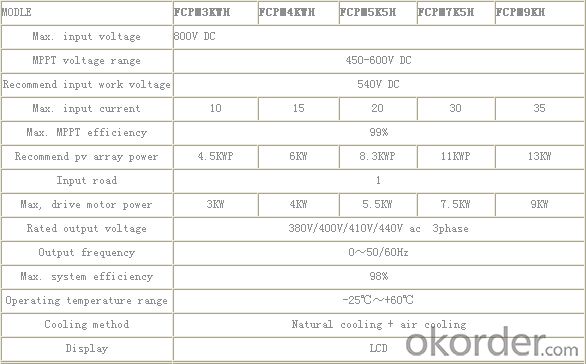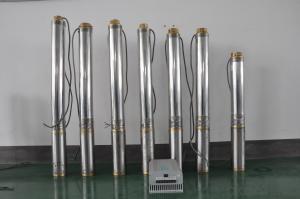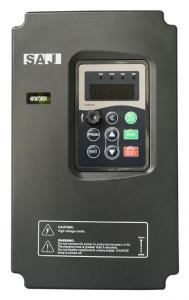Solar pump inverter FCPM9KH
- Loading Port:
- China Main Port
- Payment Terms:
- TT OR LC
- Min Order Qty:
- -
- Supply Capability:
- -
OKorder Service Pledge
Quality Product, Order Online Tracking, Timely Delivery
OKorder Financial Service
Credit Rating, Credit Services, Credit Purchasing
You Might Also Like
Solar pump inverter FCPM9KH Product Description:
Product Description:
Solar water pumping system is constructed with solar panel array,solar pump inverter and AC water pump, DC current produced from solar panel will be delivered to solar pump inverter,and it will convert it into AC current to drive water pump,and will automatically regulate output frequency according to sun radiance intensity,maximally realize MPPT tracking function.
Product Features
Adopting the proposed dynamic VI maximum power point tracking (MPPT) control method, with fast response, and reliable operation, achieves efficiency of 99%.
Designed with variable frequency driver, greatly improves efficiency
Extremely high efficiency
Digital mode control, with automatic operation and manual operation mode options
Complete protection functions
Adopts intelligent IPM module, with high reliability
LCD display and operation panel, in real time presents operating data
Optional for water level measurement and control circuit
Applicable for general ACC pumps, like centrifugal pump, piston pump etc.
Independent intellectual property; Highly effective, the redundant reliability, exempts the maintenance and the long life.
The pumps are soft started, fully protected.
No batteries are used. So better Sunlight, more water
Datasheet.

- Q:What is the installation process for a solar pump?
- The installation process for a solar pump typically involves the following steps: 1. Site Assessment: Determine the optimal location for the solar panels and pump system by considering factors such as sunlight exposure, water source proximity, and accessibility. 2. Mounting the Solar Panels: Install the solar panels in a location where they can receive maximum sunlight exposure, typically on a roof, ground-mounted rack, or pole mount. 3. Wiring and Connection: Connect the solar panels to the pump controller using appropriate wiring and connectors. Ensure proper polarity and secure connections to avoid any electrical issues. 4. Mounting the Pump: Install the pump in the desired location, ensuring it is securely anchored. Connect the pump to the water source, such as a well or water storage tank. 5. Installing the Pump Controller: Mount the pump controller near the solar panels, ensuring it is protected from harsh weather conditions. Connect the pump, solar panels, and batteries (if applicable) to the controller. 6. Testing and Commissioning: Test the system by turning on the pump and checking for proper functionality. Adjust settings on the pump controller, such as flow rate or pressure, as needed. 7. Maintenance and Monitoring: Regularly inspect and clean the solar panels to maintain their efficiency. Monitor the system's performance, including water flow, power generation, and battery charge (if applicable), to ensure optimal operation. It is important to note that the specific installation process may vary depending on the type and model of the solar pump system and local regulations. It is advisable to consult the manufacturer's installation guidelines or seek professional assistance for a successful installation.
- Q:Can a solar pump be used in areas with limited access to water conservation?
- Yes, a solar pump can be used in areas with limited access to water conservation. Solar pumps are designed to harness energy from the sun and convert it into mechanical energy to pump water. They do not rely on grid electricity or fuel, making them suitable for remote locations with limited access to water conservation. The use of solar pumps can help improve access to water for agriculture, livestock, and domestic purposes in areas where water conservation is crucial.
- Q:Can solar pumps be used for dewatering purposes?
- Yes, solar pumps can be used for dewatering purposes. Solar-powered pumps are a sustainable and cost-effective solution for pumping out water from areas such as flooded basements, construction sites, or agricultural fields. These pumps harness solar energy to power the pumping mechanism, eliminating the need for electricity or fuel. They are portable, easy to install and maintain, and can efficiently remove water from various sources, making them suitable for dewatering applications.
- Q:Can a solar pump be used for domestic water supply?
- Yes, a solar pump can be used for domestic water supply. Solar pumps use energy from the sun to power the pump, allowing it to draw water from a source such as a well or a storage tank. These pumps are efficient, reliable, and environmentally friendly, making them a suitable option for providing water for domestic purposes.
- Q:Can a solar pump be used for sewage or effluent pumping?
- No, a solar pump is not suitable for sewage or effluent pumping due to the nature of the materials being pumped. Sewage and effluent pumps require specialized equipment capable of handling solids, chemicals, and potential contaminants, which a solar pump may not be designed to handle. It is important to use appropriate pumps specifically designed for sewage or effluent applications to ensure proper functionality and avoid potential issues.
- Q:Can a solar pump be used for water transfer between reservoirs or tanks?
- Yes, a solar pump can be used for water transfer between reservoirs or tanks. Solar pumps are designed to harness solar energy and convert it into mechanical energy to move water. They are commonly used for various water transfer applications, including transferring water between reservoirs or tanks. The solar pump's efficiency, capacity, and design need to be considered to ensure it meets the specific requirements of the water transfer project.
- Q:Can a solar pump be used in areas with limited access to water systems?
- Yes, a solar pump can be used in areas with limited access to water systems. Solar pumps are designed to operate using solar energy, making them suitable for remote locations where there is no access to electricity. These pumps can draw water from wells, boreholes, rivers, or other water sources, providing a reliable and sustainable solution for water supply in areas with limited infrastructure.
- Q:Are there any maintenance requirements for a solar pump?
- Yes, there are maintenance requirements for a solar pump. Regular maintenance includes cleaning and inspecting the solar panels to ensure they are free from dirt or debris, checking the connections and wiring for any damage or loose connections, and monitoring the pump performance and water flow. Additionally, it is recommended to schedule professional inspections and servicing at least once a year to ensure optimal operation and longevity of the solar pump system.
- Q:Can a solar pump be used for water supply in refugee camps or disaster relief areas?
- Yes, a solar pump can be used for water supply in refugee camps or disaster relief areas. Solar pumps are an efficient and sustainable solution that can provide access to clean water without relying on electricity grids. They can be easily installed and operated, making them suitable for remote and off-grid locations. Solar pumps also have low maintenance requirements, making them ideal for challenging environments. Overall, solar pumps offer a reliable and environmentally friendly option for water supply in such areas.
- Q:Can a solar pump be used in reverse osmosis systems?
- Indeed, it is possible to employ a solar pump in reverse osmosis systems. Reverse osmosis, a technique for purifying water, involves the use of a semi-permeable membrane to eliminate impurities from water. To facilitate this process, pressure must be applied to counteract the natural osmotic pressure. Traditionally, an electric pump has been responsible for generating this pressure. However, an alternative option exists: the utilization of a solar pump to create the necessary pressure for reverse osmosis. Solar pumps harness solar energy to power the pump, which subsequently generates the required pressure for the process. This approach is advantageous from an environmental standpoint, as it reduces dependence on electricity and fossil fuels, making it more sustainable. Solar pumps are frequently employed in remote areas lacking access to or facing high costs for electricity. They are also particularly well-suited for off-grid applications, such as desalination plants, where reverse osmosis systems are employed to convert seawater into drinkable water. By harnessing the sun's power, solar pumps offer a cost-effective and sustainable solution for reverse osmosis systems.
1. Manufacturer Overview |
|
|---|---|
| Location | |
| Year Established | |
| Annual Output Value | |
| Main Markets | |
| Company Certifications | |
2. Manufacturer Certificates |
|
|---|---|
| a) Certification Name | |
| Range | |
| Reference | |
| Validity Period | |
3. Manufacturer Capability |
|
|---|---|
| a)Trade Capacity | |
| Nearest Port | |
| Export Percentage | |
| No.of Employees in Trade Department | |
| Language Spoken: | |
| b)Factory Information | |
| Factory Size: | |
| No. of Production Lines | |
| Contract Manufacturing | |
| Product Price Range | |
Send your message to us
Solar pump inverter FCPM9KH
- Loading Port:
- China Main Port
- Payment Terms:
- TT OR LC
- Min Order Qty:
- -
- Supply Capability:
- -
OKorder Service Pledge
Quality Product, Order Online Tracking, Timely Delivery
OKorder Financial Service
Credit Rating, Credit Services, Credit Purchasing
Similar products
New products
Hot products
Hot Searches
Related keywords

























